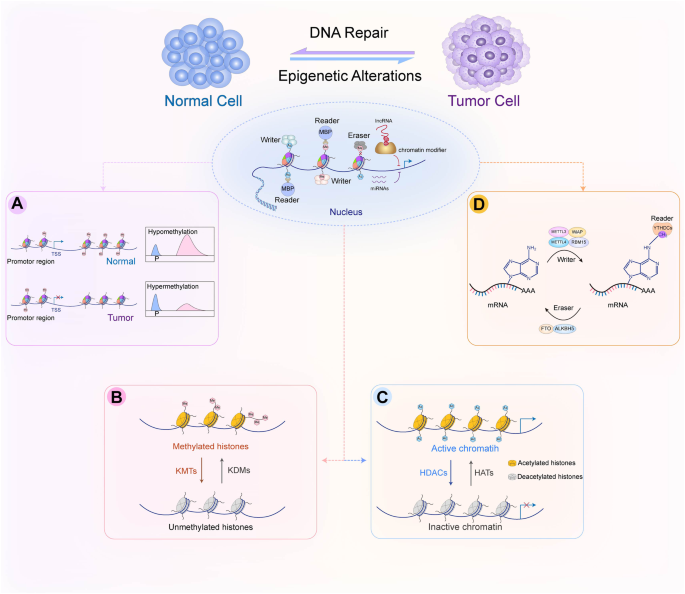Cancer epigenetics: from laboratory studies and clinical trials to precision medicine
Epigenetic dysregulation is a common feature of a myriad of human diseases, particularly cancer. Defining the epigenetic defects associated with malignant tumors has become a focus of cancer research resulting in the gradual elucidation of cancer cell epigenetic regulation. In fact, most stages of tumor progression, including tumorigenesis, promotion, progression, and recurrence are accompanied by epigenetic alterations, some of which can be reversed by epigenetic drugs. The main objective of epigenetic therapy in the era of personalized precision medicine is to detect cancer biomarkers to improve risk assessment, diagnosis, and targeted treatment interventions. Rapid technological advancements streamlining the characterization of molecular epigenetic changes associated with cancers have propelled epigenetic drug research and development. This review summarizes the main mechanisms of epigenetic dysregulation and discusses past and present examples of epigenetic inhibitors in cancer diagnosis and treatment, with an emphasis on the development of epigenetic enzyme inhibitors or drugs. In the final part, the prospect of precise diagnosis and treatment is considered based on a better understanding of epigenetic abnormalities in cancer.
Facts
Epigenetic regulatory mechanisms involve cancer biology, especially DNA methylation, histone acetylation, and miRNAs.
The expression of tumor-related genes is closely related to the epigenetic regulatory process of tumors.
DNMTi, HDACis, BETis and other epigenetic therapies are constantly being updated and used in the clinic.
Epigenetic combination therapy is a promising direction.
Multi-omics, gene therapy, and AI are favorable transitions from epigenetic therapy to precision medicine.
Mechanisms of epigenetic dysregulation in cancer
Epigenetics is defined as a series of biological processes involving chromatin-mediated DNA template regulation, independent of changes in the original DNA sequence. Protein complexes that control epigenetic modifications (including DNA methylation and covalent histone modification) can be divided into writers, readers, and erasers. Epigenetic writers add distinct epigenetic chemical modifications to DNA or histones in the form of epigenetic markers. Readers are methyl-CpG-binding domain proteins (MBPs) that identify and interpret the specialized domains of modified proteins. Chromatin-modifying enzymes function as erasers by removing epigenetic markers. Epigenetic dysregulation, including DNA, RNA methylation defects and abnormal post-translational modification processes, is commonly associated with all cancer types.

Epigenetic alterations involve DNA methylation, histone acetylation, and miRNA regulation that have reversible effects on gene silencing and activation through epigenetic enzymes and related proteins. Writers (DNMT, HAT, and KMT) are enzymes that add acetyl (Ac) and methyl (Me) tags to histones. MBDs are readers that recognize methyl-CpG and modify histones. Erasers (DNA demethylase, HDAC, and KDM) are responsible for removing chemical groups from DNA or histones. Noncoding RNAs (miRNAs and lncRNAs) are also involved in epigenetic regulation. A DNA methylation in normal and cancer cells. The overall hypomethylation and local hypermethylation of promoter regions are characteristics of cancer cells. P: promoter region. B Methylation and demethylation of lysine or arginine in histones. Lysine can be methylated once (me1), twice (me2) or three times (me3) catalyzed by KMT. Arginine is methylated once (me1) or twice (me2) catalyzed by KMT. These processes can be reversed by KDM. C HDAC removes acetyl groups from histone lysine residues. Acetylated histones are considered “active chromatin” allowing gene transcription, whereas deacetylated histones are “non-active chromatin” associated with gene silencing. D The methylation of m6A is installed by the RNA methyltransferase complex with the catalytic subunit METTL3/METTL4 (writer) and removed by demethylases, such as FTO and ALKBH5 (eraser). m6A reader proteins (YTHDCs) can specifically bind m6A transcripts. DNMT, DNA methyltransferase; HAT, histone acetyltransferase; HDAC, histone deacetylase; KDM, lysine demethylase; KMT, lysine methyltransferase; m6A, N6-Methyladenosine. MBP, methyl-CpG-binding domain protein.
International Conference on Genetics and Genomics of Diseases
Award Nomination: genetics-conferences.healthcarek.com/award-nomination/?ecategory=Awards&rcategory=Awardee
Award registration: genetics-conferences.healthcarek.com/award-registration/
For Enquiries: genetics@healthcarek.com
Get Connected Here
---------------------------------
---------------------------------

Comments
Post a Comment